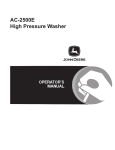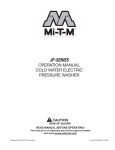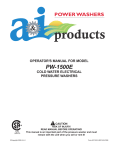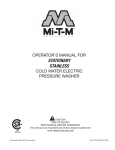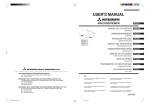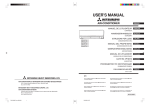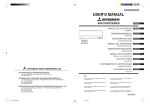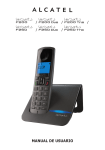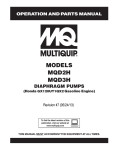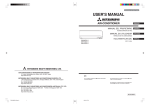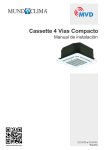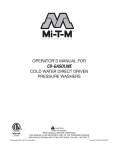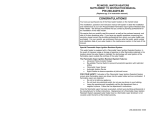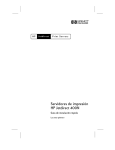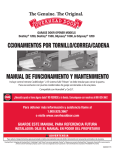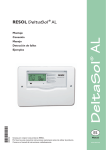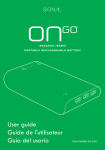Download CHV SERIES - Mi-T
Transcript
OPERATOR'S MANUAL FOR CHV SERIES COLD WATER BELT DRIVEN PRESSURE WASHER CAUTION RISK OF INJURY! READ MANUAL BEFORE OPERATING! This manual is an important part of the pressure washer and must remain with this unit! ©Copyright Mi-T-M Corporation Operator's 2006, Manual Form #37-0965-E/S-010307 table of contents introduction.............................................................................................................................. 3 important safety warningS.............................................................................................4-7 ELECTRICAL PRECAUTIONS............................................................................................ 4 SPRAY PRECAUTIONS...................................................................................................... 5 MISCELLANEOUS SAFETY PRECAUTIONS.................................................................... 6 ADJUSTMENT PRECAUTIONS.......................................................................................... 7 features & safety decals.................................................................................................8-9 INSTALLATION & PREPARATION..........................................................................................10-14 ATTIRE.............................................................................................................................. 10 SETUP............................................................................................................................... 10 WATER SUPPLY................................................................................................................ 11 BASIC PLUMBING DIAGRAM........................................................................................... 13 CONTROL UNIT................................................................................................................ 14 PULSATION DAMPENER................................................................................................. 14 POWER CORD CONNECTION......................................................................................... 14 PRE-START INSPECTION PROCEDURES...................................................................... 14 OPERATING INSTRUCTIONS.................................................................................................16-17 START-UP.......................................................................................................................... 16 SHUTDOWN...................................................................................................................... 17 STORAGE & MAINTENANCE..................................................................................................18-19 SPECIFIC MAINTENANCE .............................................................................................. 18 BELT TENSION ADJUSTMENT........................................................................................ 18 WINTERIZING................................................................................................................... 19 TROUBLESHOOTING..............................................................................................................20-21 statement of warranty...................................................................................................... 22 notes......................................................................................................................................23-25 Operator's Manual INTRODUCTION Congratulations on the purchase of your new Mi-T-M Cold Water Pressure Washer! You can be assured your pressure washer was constructed and designed with quality and performance in mind. Each component has been rigorously tested to ensure the highest level of acceptance. This operator's manual was compiled for your benefit. By reading and following the simple safety, installation, operation, maintenance and troubleshooting steps described in this manual, you will receive years of trouble free operation from your new pressure washer. The contents of this manual are based on the latest product information available at the time of publication. Mi-T-M reserves the right to make changes in price, color, materials, equipment, specifications or models at any time without notice. ! important ! These paragraphs are surrounded by a "SAFETY ALERT BOX". This box is used to designate and emphasize Safety Warnings that must be followed when operating this pressure washer. Accompanying the Safety Warnings are "signal words" which designate the degree or level of hazard seriousness. The "signal words" used in this manual are as follows: DANGER:Indicates an imminently hazardous situation which, if not avoided, WILL result in death or serious injury. WARNING:Indicates a potentially hazardous situation which, if not avoided, COULD result in death or serious injury. CAUTION:Indicates a potentially hazardous situation which, if not avoided MAY result in minor or moderate injury. The symbols set to the left of this paragraph are "Safety Alert Symbols". These symbols are used to call attention to items or procedures that could be dangerous to you or other persons using this equipment. ALWAYS PROVIDE A COPY OF THIS MANUAL TO ANYONE USING THIS EQUIPMENT. READ ALL INSTRUCTIONS BEFORE OPERATING THIS PRESSURE WASHER AND ESPECIALLY POINT OUT THE "SAFETY WARNINGS" TO PREVENT THE POSSIBILITY OF PERSONAL INJURY TO THE OPERATOR. Once the unit has been uncrated, immediately write in the serial number of your unit in the space provided below. SERIAL NUMBER_________________________________ Inspect for signs of obvious or concealed freight damage. If damage does exist, file a claim with the transportation company immediately. Be sure that all damaged parts are replaced and that the problems are corrected prior to operation of the unit. If you require service, contact Mi-T-M Customer Service at our toll-free number: 800-553-9053 Monday - Friday 8:00 a.m. - 5:00 p.m. Central Standard Time Please have the following information available for all service calls: 1. Model Number 2. Serial Number 3. Date and Place of Purchase Operator's Manual IMPORTANT SAFETY instructions ELECTRICAL PRECAUTIONS 1. GROUNDING INSTRUCTIONS: This product must be grounded. If it should malfunction or breakdown, grounding provides a path of least resistance for electric current to reduce the risk of electric shock. This product is equipped with a cord having an equipment-grounding conductor and a grounding plug. The plug must be plugged into an appropriate outlet that is properly installed and grounded in accordance with all local codes and ordinances. 2. DANGER: Improper connection of the equipment-grounding conductor can result in a risk of electrocution. Check with a qualified electrician or service personnel if you are in doubt as to whether the outlet is properly grounded. Do not modify the plug provided with the product - if it will not fit the outlet, have a proper outlet installed by a qualified electrician. Do not use any type of adaptor with this product. WARNING To reduce the risk of electrocution, keep all connections dry and off the ground.Do not touch plug with wet hands. 3. DO NOT pull on the electrical cord to disconnect from the outlet. 4. Check power cord for damage before using. There is a hazard of electrical shock from crushing, cutting or heat damage. 5. Always be certain the unit is receiving proper voltage. Before plugging the unit into a compatible power source, be certain the switch is in the "OFF" position. Disconnect when not in use. 6. DO NOT use the unit in an area where flammable gas vapors may be present. An electric spark could cause an explosion or fire. 7. DO NOT direct water spray on or into electrical installations of any kind. This includes electrical outlets, light bulbs, fuse boxes, transformers, the unit itself, etc. Severe electrical shock may occur. 8. The manufacturer does not recommend that the owner attempt any electrical repairs to this unit. Operator's Manual IMPORTANT SAFETY instructions spray precautions: DANGER risk of injection or severe cutting injury keep clear of nozzle. do not direct discharge stream at persons or pets. only trained operators should use this product. basic precautions should always be OBSERVED, including the following: 1. KEEP AWAY FROM THE SPRAY: a. Because of the high pressure and velocity of the spray, fluids can penetrate the skin, causing serious injury. b. Never point the gun at yourself or anyone else. Never put your hand, fingers or body directly over the spray nozzle. Always keep operating area clear of all persons. Use extreme caution when operating near children. c. If an accident does occur and the spray appears to have penetrated the skin, SEEK EMERGENCY MEDICAL CARE. DO NOT TREAT AS A SIMPLE CUT. 2. ALWAYS wear protective goggles when operating the unit to shield the eyes from flying debris and detergents. Other protective equipment such as rubber suits, gloves and boots are advisable. Use extreme caution when operating near children. 3. Stay alert-watch what you are doing. Do not operate the unit when fatigued or under the influence of alcohol or drugs. 4. NEVER squeeze the trigger unless securely braced. The thrust from the water traveling through the nozzle may be powerful enough to cause the operator to lose balance if unprepared. DO NOT overreach or stand on unstable support. Wet surfaces can be slippery, wear protective foot gear and keep good footing and balance at all times. NEVER trigger the gun while on a ladder or roof. 5. Caution should be used when directing spray toward fragile materials such as glass. Shattering could result in serious injury. 6. ALWAYS hold on firmly to the gun/wand assembly when starting and operating the unit. Failure to do so can cause the wand to fall and whip dangerously. Operator's Manual IMPORTANT SAFETY instructions miscellaneous safety precautions: 1. NEVER ALLOW CHILDREN OR ADOLESCENTS TO OPERATE THIS UNIT! 2. Read and follow all handling, operations, maintenance and safety instructions listed in this manual and provide such information to ANYONE who will be operating this unit. 3. In freezing temperatures, the unit must always be warm enough to ensure there is no ice formation in the pump. DO NOT start this unit if it has been transported in an open or underheated vehicle without first allowing the pump to thaw. 4. High pressure hoses should be inspected daily for signs of wear. If evidence of failure exists, promptly replace all suspect hoses to prevent the possibility of injury from the high pressure spray. If a hose or fitting is leaking , NEVER place your hand directly on the leak. 5. DO NOT operate the unit if you see any pump oil or water leaks from the machine. DO NOT resume operation until the unit has been inspected and repaired by a qualified service person. 6. DO NOT operate the unit without all protective covers in place. 7. To reduce the risk of injury, maintain a safe distance from persons while operating this unit. Close supervision is necessary when operating the unit near children. 8. Shut off the unit power switch before leaving. Operator's Manual IMPORTANT SAFETY instructions adjustment precautions: 1. NEVER alter or modify the equipment, be sure any accessory items and system components being used will withstand the pressure developed. Use ONLY genuine manufacturer parts for repair of your pressure washer. Failure to do so can cause hazardous operating conditions and will void warranty. 2. NEVER make adjustments to the machinery while it is connected to the power source. 3. Know how to stop the pressure washer quickly. Be thoroughly familiar with controls. 4. Before servicing the unit; turn the unit off, relieve the water pressure, and allow the unit to cool down. Service in a clean, dry, flat area. 5. Follow the maintenance instructions specified in this manual. ! save these instructions ! Operator's Manual CHV-EEATURES-091106-JJT FEATURES FEATURES LISTING 1. Motor 2. Electric Plug 3. Power Cord 4. Power Switch 5. Start Button 6. Decal-Warning/Caution/Operation 7. Electric Box 8. Dome Isolator 9. Solenoid Valve 10. Garden Hose Connection 11. Fresh Water Outlet - To Tank 12. High Pressure Outlet 13. High Pressure Hose 14. Gun Trigger 15. Decal - Warning Risk of Injection 16. Adjustable Spray Pattern Lever 17. Long Range Gun w/Nozzle 18. Mini Flow Switch 19. Pump Inlet 20. Ventilation Openings 21. By-Pass Outlet 22. Diaphragm Pump 23. Decal - Beltguard in Place 24. Oil Fill/Sightglass 25. Outlet Pressure Guage 26. Beltguard 27. Dump Lever Operator's Manual SAFETY DECALS & PLACEMENT DO not remove safety decals from unit unless replacing with most current safety decal!! Decal: Warning: Beltguard in Place (Part #34-0575) Decal: Warning: Risk of Injection (Part #34-1253) ADVERTENCIA WARNING RISK OF INJECTION OR SEVERE INJURY. RIESGO DE INYECCION O LISION SEVERA Never put your hand, fingers or body directly Nunca coloque la mano, los dedos o el cuerpo over the spray nozzle. directamente sobre la boquilla de rocío. 34-1253-030801-ENG. Decal: Warning/Caution/Operating Instructions (Part #34-0925) WARNING •Risk of Injection or Severe Injury: Keep clear of nozzle. Do not direct high pressure spray at any person or self. This machine is to be used by qualified operators. •Risk of Electrocution: Do not direct spray toward any electrical connections or outlets. Use extreme caution while operating near any electrical power lines. Use extreme safety precautions due to high voltage involved. •Risk of Explosion: Do not spray flammable liquids or in an area containing combustible dust, liquids, or vapors. •Risk of Injury: Use only properly rated components with this unit. Close supervision is necessary when this product in near children. •Risk of Chemical Exposure: Use only water and recommended detergents with this unit. CAUTION •Read and understand all instructions and operation manual before using. Check local codes regarding cross connection to water supply. •Stay alert: Hold on to gun/wand firmly with both hands to avoid dangerous kickbacks. •Do not overreach or stand on unstable support. Keep good footing and balance at all times. •Inspect all hoses for kinking, cuts, and leaks. •Eye goggles and appropriate protection is recommended while operating this unit. •Protect pump from freezing. •Always turn on water supply to pump before starting. •Engage trigger safety lock-off when not in use. OPERATION •Be certain that the motor switch is in the "OFF" position before inserting plug into electrical outlet. Be sure that the correct electrical system (voltage, amp, capacity, etc.) is supplied for this unit. •Turn on adequate water supply and trigger gun to prime pump and release air. •After starting the unit: Point gun in a safe direction, brace wand securely to avoid recoil and hold trigger. •After stopping the unit, always turn off water supply and trigger spray gun to release pressure. •Observe lubrication and maintenance recommendations as listed in the operator's manual. 34-0925-031802-ENG. Operator's Manual 10 Operator's Manual INSTALLATION & PREPARATION attire: Proper attire is essential to your safety. Utilize whatever means necessary to protect eyes, ears, and skin. warning RISK OF EXPLOSION or fire! do not operate unit in an area where flammable g a s va p o r s m ay b e present. a spark can cause an explosion or fire! risk of UNIT BURSTING! do not store or operate unit in a freezing environment! SETUP: 1. This u nit should only be placed on a level surface to ensure proper lubrication for the water pump while operating. NEVER spray water directly on the unit! 2. DO NOT place unit in an area: a. where there is evidence of oil or gas leaks b. where flammable vapors may be present. 3. Do not allow the unit to be exposed to rain, snow or freezing temperatures. If any part of the unit becomes frozen; excessive pressure may build up in the unit which could cause it to burst which could result in serious injury to the operator or bystanders. 4. Pump oil level should be checked before each use to be certain the oil level is in the center of the sight glass. If low, fill with SAE 40W Hydraulic Lubricant pump oil. DO NOT OVERFILL! Operator's Manual11 INSTALLATION & PREPARATION Typical Water Supply Hookup: 1. Select a Garden hose measuring at least 3/4" ID and no longer than 50 feet. Connect one end of the MAKE-UP water supply garden hose to the MAKE-UP water inlet of the unit. Connect the other end of the hose to your pressurized water supply. Note: When connecting the make-up water inlet to the water supply mains, local regulations of your water company must be observed. In some areas, the unit must not be connected directly to the public drinking water supply. This is to ensure that there is no feedback into the water supply. (Direct connection is permitted if a back flow preventer is installed.) 2. Connect the make-up water hose from unit to tank. (Optional CX-0072 tank) Twenty five feet of 3/4” low pressure hose #15-0033 is supplied with the unit. The makeup water supply alone will not supply the water requirements of the unit. Note: The diaphram pump will not suffer if run dry due to any empty tank. However a starved suction due to a clogged strainer or closed valve in the pump inlet line will cause premature failure of the pump diaphrams. 3. Connect a 1-1/2 inch non collapsable inlet hose from the tank to the pump inlet. Hose and connectors are not supplied with unit. 1-1/2” Non collapsable hose #15-0212 and 1-1/2” cam and groove connector #55-0053 (two required) can be purchased separately. Twenty five feet of hose with connectors is supplied with CX-0072. Typical installation includes a shut off ball valve (suction valve) and a large area filter with 10-20 mesh screen (included with CX-0072). Never use a fine filter screen with a diaphram pump. 4. Connect bypass outlet hose from pump to tank. Twenty five feet of 3/4” low pressure hose #15-0033 (50 ft total) is supplied with the unit. 5. Quick-connect the high pressure discharge hose to the water outlet of the unit. Connect the other end of the discharge hose to the gun. 6. A sump pump from a pit or recycle system is typically routed to the tank to provide enough water to keep the tank from running out. (Not Provided) 7. An overflow hose from the top of the tank is typically routed back to the pit. 12 Operator's Manual INSTALLATION & PREPARATION OPTIONAL WATER HOLDING TANK CX-0072 FLOAT VALVE IN TANK FIELD INSTALLED WIRING SHUTOFF VALVE LONG RANGE GUN WITH NOZZLE (WITH UNIT) TYPICAL FROM SUMP PUMP BALL VALVE OPTIONAL HOSE REEL 50-0185 INLET FILTER TYPICAL INSTALL OVERFLOW HOSE HIGH PRESSURE 50 FT. OUTLET HOSE (WITH UNIT) WATER RECYCLE SYSTEM / PIT / SUMP PUMP SLUDGE DISCHARGE 3/4" LOW PRESSURE BY-PASS OUTLET HOSE 25' WITH UNIT (15-0033) CHV UNIT CHV NONCOLLAPSABLE 25' INLET HOSE WITH CX-0072 (15-0212) 3/4" GARDEN HOSE TO MAKEUP WATER INLET 3/4" LOW PRESSURE HOSE TO MAKEUP WATER TANK INLET 25' WITH UNIT (15-0033) SOLD SEPARATELY 1 1/2" CAM AND GROOVE ADAPTER QTY. 2 WITH CX-0072 (55-0053) 1 1/2" SUCTION HOSE ORDERED PER FT. 25' WITH CX-0072 OPTION (15-0212) Operator's Manual13 INSTALLATION & PREPARATION control unit: The pressure has been preset at the factory and should only be adjusted by a trained Mi-T-M Customer Service Representative. pulsation dampener: It is the nature of diaphragm pumps to have some pulsation. This is caused by sudden changes in piston direction. The pulsation dampener has one function in the pumping system, reduce pulsation by providing a cushion of air to bump against. The pulsation dampener uses a rubber bladder to separate the air cushion from the solution being pumped. The basic rule is to fill the pulsation dampener to twenty percent (20%) of the system working pressure. If you have your spraying pressure set at 100 psi, the setting for the pulsation dampener should be 20 psi. Always shut down the pump before adding air to the pulsation dampener or checking its pressure. Air supply can be from a compressor or a manual type pump. The dome containing air is small. Take care to apply the pressure guage evenly on the air valve to prevent air from leaking out of the pulsation dampener. It is not uncommom to lose 5-10 psi when checking pulsation dampener pressure. NOTE: 2-cylinder diaphragm pumps may require more air than 20% of operating pressure. 20 psi is the minimum pulsation dampener pressure. DO NOT RUN PUMP WITH LESS THAN 20 PSI IN THE PULSATION DAMPENER. warning risk of electrocution! This unit must be connected to a properly grounded outlet. DO NOT use an adapter OR remove the grounding prong. power cord connection: 1. Make certain the motor switch is in the "OFF" position. 2. Ensure electrical supply matches that shown on identification plate located on unit base plate. 3. Ensure the area between the pressure washer cord and the outlet is kept dry. 4. Insert the male plug into a properly grounded AC outlet. DO NOT use an adapter OR remove the grounding prong! pre-start inspection procedures: Before starting the unit, perform the following procedures: 1. Check the oil level in the pump. 2. Inspect the inlet water strainer (not supplied with unit/with cx-0072). Clean or replace if necessary. 3. Check all hose connections to ensure they are securely tightened. 4. Open Suction Valve and check tightness of suction lines, fittings and filter. 5. Inspect for system water leaks and oil leaks. Be sure that all damaged parts are replaced and that the mechanical problems are corrected prior to operation of the unit. If service is needed, contact an Authorized Service Center. 6. The diaphragm pump will not suffer if run dry due to an empty tank. However, a "starved" suction due to a clogged strainer or closed suction valve will cause premature failure of the pump diaphragm pump. 7. Inspect high pressure hose for kinking, cuts or leaks. If a cut or leak is found, DO NOT USE HOSE! Replace hose before starting unit. See "Miscellaneous Safety Precautions" #4. Be sure that all damaged parts are replaced and that the mechanical problems are corrected prior to operation of the unit. If you need service, contact an Authorized Service Center. 8. Inspect electrical cord for cuts. If a cut is found, DO NOT TOUCH OR USE ELECTRICAL CORD! Replace cord before starting the unit. 14 Operator's Manual INSTALLATION & PREPARATION warning THE FOLLOWING PAGES CONTAIN OPERATING AND MAINTENANCE INSTRUCTIONS. do not attempt to operate this pressure washer until you have read and understood all safety precautions and instructions listed in this manual. incorrect operation of this unit can cause serious injury!! do not alter or modify this equipment in any manner! Operator's Manual15 OPERATING INSTRUCTIONS danger RISK OF INJECTION CAUSING SEVERE INJURY! -KEEP CLEAR OF NOZZLE! NEVER PLACE HAND OR FINGERS IN FRONT OF NOZZLE! -DO NOT DIRECT DISCHARGE STREAM AT PEOPLE OR PETS! -be certain the nozzle is securely connected to the wand to prevent accidental discharge. CAUTION RISK OF DAMAGE. do not allow spray pattern to remain on a fixed area for an extended period of time. possible damage may occur to the area. 16 START-UP: 1. Refer to the "Safety Precautions" pgs. 4-7 before starting the unit. 2. Lay the high pressure hose out to remove any loops. Water flow will constrict the hose creating tight loops if the hose is not straight. 3. Securely connect the gun/wand assembly to the high pressure hose. 4. Push the manual dump valve lever down so the pump will start in bypass mode. Turn the water supply completely on. 5. The diaphragm pump will not suffer if run dry due to an empty tank. However a “starved” suction due to a clogged strainer screen or a closed suction valve will cause premature failure of the pump diaphragms. Important: keep suction valve open whenever system is being operated 6. Move the toggle switch to the "ON" position and push the green start button to turn on the unit. 7. Water will begin flowing through the bypass hose back to the water supply tank. This allows the unit to prime and purge any air from the system. The unit is primed when water flow is uninterrupted by air. 8. Return dump valve lever to the "UP" position. 9. Point the gun in a safe direction and squeeze the trigger. Brace yourself, as the gun will kickback from the force of the water exiting the nozzle. 10. Once the unit is turned on, perform the following procedures with the gun open: a. Inspect for system water leaks and oil leaks. If a leak is found, TURN the UNIT OFF! Be sure that all damaged parts are replaced and that the mechanical problems are corrected prior to operation of the unit. If you require service, contact Customer Service. b. Inspect high pressure hose for kinking cuts and leaks. If a cut or leak is found, DO NOT TOUCH HOSE AT CUT OR LEAK!!! TURN the UNIT OFF! Replace hose before restarting the unit. Be sure that all damaged parts are replaced and that the mechanical problems are corrected prior to operation of the unit. If you require service, contact Customer Service. c. Inspect electrical cord for cuts. If a cut is found, DO NOT TOUCH ELECTRICAL CORD AT CUT!!! TURN UNIT OFF IMMEDIATELY! 11. Trigger the gun several times. NEVER look directly into the nozzle! High pressure water creates a risk of severe injury! Operator's Manual OPERATING INSTRUCTIONS Shutdown: 1. The unit is equipped with time delay shutdown. It will shut down automatically when the gun has not been triggered for the duration of the timer setting. 2. Move the toggle switch to the "OFF" position to turn unit power off before leaving the unit. Do not leave the unit unattended without turning the toggle switch to the off position. The unit may restart for a short period of time after the time delay shutdown is activated if the gun trigger is squeezed during that time. 3. Disconnect the unit from the power source. 4. Turn garden hose make up water supply "OFF". 5. Pointing the gun in a safe direction, trigger gun to ensure there is no trapped pressure. 6. Disconnect and drain the gun, wand and hoses. 7. Wipe unit clean. Store the gun, wand and hoses in a safe area. Operator's Manual17 STORAGE & MAINTENANCE specific maintenance: PUMP: Change the pump oil after the first 50 hours of operation. After initial change, every year or 500 hour intervals are recommended. If oil appears dirty or milky, changes may be required in greater frequency. Use SAE 40W Hydraulic Lubricant pump oil and fill only to the center of the oil sight glass. Change Pump diaphragms every 500 hours. Inspect check valves for spring fatigue and seat wear. QUICK COUPLERS: There is an o-ring seal inside the female quick-coupler. This o-ring will deteriorate or, if the unit is allowed to pump without the high pressure hose attached, it may be blown out occasionally. Simply insert a replacement o-ring to correct the leak. (New orings can be purchased from your dealer.) BELT TENSION ADJUSTMENT: To maintain peak performance of your pressure washer, it may be necessary to adjust the belt tension on occasion. Follow the procedure outlined below. 1. Remove the belt guard and loosen the two nuts on each side of the motor. (Reference A) There are a total of 4 nuts. 2. Turn the cap screw (Reference B) clockwise until a 1/2 inch belt deflection is noticed between the pulleys. 3. Tighten the motor nuts. (Reference A) 4. Put a straight edge across both pulleys to check belt alignment. 5. Replace the beltguard and tighten the fasteners securely. belt tension adjustment A 18 B Operator's Manual STORAGE & MAINTENANCE winterizing: For storage and transportation purposes in subfreezing ambient temperatures, it will be necessary to winterize this unit. This unit must be protected to the lowest incurred temperature for the following reasons: 1. If any part of the pumping system becomes frozen; excessive pressure may build up in the unit which could cause the unit to burst resulting in possible serious injury to the operator or bystanders. 2. The pumping system in this unit may be permanently damaged if frozen. FREEZE DAMAGE IS NOT COVERED BY WARRANTY. If you must store your unit in an area where the temperature may fall below 32°F, you can protect your unit by following the procedure outlined below. 1. Gather the following items: a. Two 5 gallon containers. b. One gallon of antifreeze. (Mi-T-M recommends an environmentally safe antifreeze.) c. Water supply. d. Three foot suction hose with a 1 1/2 inch cam and groove adapter (Mi-T-M #15-0212). 2. Procedure: a. Shut off the unit and water supply. b. In a 5 gallon container, mix the antifreeze and water according to manufacturer's recommendations for the temperature to which you are winterizing. NOTE: warning risk of UNIT BURSTING! do not store or operate unit in a freezing environment! 32˚F 0˚C Proper winterizing is based on the recommended manufacture's instructions listed on the "Protection Chart" shown on the back label of most antifreeze containers. c. Remove the water supply hose from the unit and attach the 3 foot hose securely to the inlet connection. Submerge the opposite end into the antifreeze solution. d. Point the wand into the empty container in cone mist mode. e. Trigger the gun and start the unit. Continue until all the antifreeze mixture is siphoned from the container. f. Detach the 3 foot hose from the unit and drain any excess antifreeze back into the 5 gallon container. g. Disconnect the hose/gun/wand assembly from the unit and drain any excess antifreeze back into the 5 gallon container. h. Store the hose, gun and wand with the unit in a safe area. i. Store antifreeze solution for next use or dispose of according to state EPA laws. 3. Optional Procedure: a. Shut off the unit and disconnect the pump inlet water supply hose. b. Point the trigger gun in a safe direction and squeeze the trigger until water flow ceases to exit the nozzle. c. Disconnect and drain the hose, gun and wand. d. Start the unit and allow it to run until all the water exits the unit. Once the water has stopped flowing from the unit, turn the unit off. NOTE: When using this procedure, caution should be used as ice chips can form from drops of water which could cause the unit to burst if starting before completely thawed. Operator's Manual19 Troubleshooting SYMPTOM PROBABLE CAUSE REMEDY Pump motor will not start, or stops Tripped circuit breaker or fuse blown in circuit fuse box. Disconnect all other plugs on the circuit being used and reset circuit breaker OR check and replace fuse. Loose or disconnected plug. Reconnect plug. Tripped circuit breaker in unit. Allow to cool and restart unit. Unit is frozen. Allow to thaw. If any part of the unit becomes frozen; excessive pressure may build up in the unit which could cause the unit to burst resulting in possible serious injury to the operator or bystanders. Circuit breaker trips or fuse blows Circuit overload. the fuse box. Check that the circuit is rated in correctly. Disconnect all plugs on the circuit. When connecting to a circuit protected by fuses, use time delay fuses only. Motor runs but there is no discharge Inadequate water supply. at nozzle when trigger mechanism is squeezed. Ensure hose is 3/4" diameter and incoming water supply is turned on. Remove kink. 20 Kink in water inlet hose. Operator's Manual Troubleshooting SYMPTOM PROBABLE CAUSE REMEDY Low or fluctuating pressure. Kink in high pressure discharge hose. Replace kinked pressure hose. Water inlet screen obstructed. Pump sucking air. (Prime lost) Obstructed or worn spray nozzle. Remove screen, clean or replace. Damaged or obstructed valve assy. Bypass valve not operating correctly. Remove, inspect, clean or replace. Oil appears milky or foamy. One or more diaphragms have ruptured. Replace diaphragms Oil leaking from unit. DO NOT USE!!!!! Contact Customer Service. Water flows from the nozzle when the trigger gun is turned off. Gun is malfunctioning. Repair or replace. Operator's Manual Tighten all water intake connections. Eliminate leaks in intake line. Remove and clean, or replace. Repair or replace. 21 STATEMENT OF WARRANTY Mi-T-M warrants all parts, (except those referred to below), of your new belt driven pressure washer to be free from defects in materials and workmanship during the following periods: For One (1) Years from the date of original purchase: High Pressure Pump For Two (2) Years from the date of original purchase: Pulleys Plumbing For One (1) Year from the date of original purchase: Selector Switch Starter Contactor Overload For Ninety (90) Days from the date of original purchase: Trigger Gun/Wand High Pressure Hose Unloader Valve Defective parts not subject to normal wear and tear will be repaired or replaced at our option during the warranty period. In any event, reimbursement is limited to the purchase price paid. exclusions 1. The motor is covered under separate warranty by its respective manufacturer and is subject to the terms set forth therein. 2. 3. Normal wear parts: Pump Diaphrams Quick Couplings/Screw Connects Spray Nozzles Detergent Valves Pump Valves O-rings Belts This warranty does not cover parts damaged due to normal wear, misapplication, misuse, operation at other than recommended speeds, pressures or temperature. Parts damaged or worn because of the use of caustic liquids or by operation in abrasive or corrosive environments or under conditions of "starved suction" are not warranted. Failure to follow recommended operating and maintenance procedures also voids warranty. 4. The use of other than genuine Mi-T-M repair parts will void warranty. Parts returned, prepaid to our factory or to an Authorized Mi-T-M Service Center will be inspected and replaced free of charge if found to be defective and subject to warranty. There are no warranties which extend beyond the description of the face hereof. Under no circumstances shall the Mi-T-M Corporation bear any responsibility for loss of use of the unit, loss of time or rental, inconvenience, commercial loss or consequential damages. For Service or Warranty Consideration, contact: Mi-T-M Corporation / 8650 Enterprise Drive, Box 50 / Peosta, IA 52068-0050 563-556-7484 / 800-553-9053 / Fax 563-556-1235 Monday - Friday / 8:00 a.m. - 5:00 p.m. CST 22 Operator's Manual notes Operator's Manual 23 notes 24 Operator's Manual notes Manual del Operador 25 TABLA DE MATERIAS INTRODUCCION............................................................................................................................................... 27 ADVERTENCIAS IMPORTANTES DE SEGURIDAD.................................................................................. 28-31 PRECAUCIONES ELECTRICAS................................................................................................... 28 PRECAUCIONES PARA ROCIADO.............................................................................................. 29 PRECAUCIONES MISCELANEAS DE SEGURIDAD................................................................... 30 PRECAUCIONES DE AJUSTE...................................................................................................... 31 ELEMENTOS Y COMPONENTES............................................................................................................... 32-33 INSTALACION Y PREPARACION ............................................................................................................. 35-38 PROTECCIÓN PERSONAL........................................................................................................... 35 PREPARACION............................................................................................................................. 35 ABASTECIMIENTO DE AGUA....................................................................................................... 36 DIAGRAMA BÁSICO DE LA PLOMERÍA....................................................................................... 37 UNIDAD DE CONTROL................................................................................................................. 38 HUMIDIFICADOR DE LA PULSACIÓN......................................................................................... 38 CONEXIÓN DE CABLE DE ALIMENTACIÓN ELéCTRICA........................................................... 38 PROCEDIMIENTOS DE INSPECCION ANTES DEL ARRANQUE............................................... 38 INSTRUCCIONES DE OPERACION........................................................................................................... 40-35 EMPIECE PARA ARRIBA............................................................................................................... 40 CERRADO..................................................................................................................................... 41 ALMACENAMIENTO Y MANTENIMIENTO................................................................................................ 42-44 MANTENIMIENTO ESPECIFICO.................................................................................................. 42 BELT TENSION ADJUSTMENT..................................................................................................... 42 PREPARACION PARA EL INVIERNO...................................................................................... 43-44 LOCALIZACION DE FALLAS.......................................................................................................................... 45 NOTA................................................................................................................................................................. 46 DECLARACION DE GARANTIA...................................................................................................................... 47 26 Manual del Operador INTRODUCCION ¡Felicitaciones por la compra de su nueva lavadora a presión! Puede estar seguro que su lavadora a presión fue construida con el nivel más alto de precisión y exactitud. Cada componente ha sido probado rigurosamente por técnicos para asegurar la calidad, la resistencia y el rendimiento de esta unidad. Este manual del operador fue compilado para su beneficio. Leyendo y siguiendo los pasos simples de seguridad, instalación, operación, mantenimiento y localización de fallas descritos en este manual ayudará a prolongar aun más la operación libre de fallas que usted puede esperar de su nueva lavadora a presión. El contenido de este manual está basado en la información actualizada disponible al momento de la publicación. Mi-T-M® se reserva el derecho de efectuar cambios en precio, color, materiales, equipo, especificaciones o modelos en cualquier momento sin previo aviso. ¡IMPORTANTE! Estos párrafos están rodeados por una “CASILLA DE ALERTA DE SEGURIDAD”. Esta casilla se usa par designar y enfatizar las Advertencias de Seguridad que deben seguirse al operar esta lavadora a presión. Acompañando a las Advertencias de Seguridad están las “palabras de alerta” que designan el grado o nivel de seriedad de riesgo. Las “palabras de alerta” usadas en este manual son las siguientes: PELIGRO: Indica una situación inminente riesgosa la cual, si no se evita, RESULTARA en la muerte o en lesiones graves. ADVERTENCIA: Indica una situación potencialmente riesgosa la cual, si no se evita, PODRIA resultar en la muerte o en lesiones graves. PRECAUCION: Indica una situación potencialmente riesgosa la cual, si no se evita PUEDE resultar en lesiones menores o moderadas. El símbolo indicado a la izquierda de este párrafo es el “Símbolo de Alerta de Seguridad”. Este símbolo se usa para alertarlo acerca de artículos o procedimientos que podrían ser peligrosos para usted u otras personas usando este equipo. PROVEA SIEMPRE UNA COPIA DE ESTE MANUAL A CUALQUIER PERSONA QUE USE ESTE EQUIPO. LEA TODAS LAS INSTRUCCIONES ANTES DE OPERAR ESTA LAVADORA A PRESION, OBSERVANDO EN PARTICULAR LAS “ADVERTENCIAS DE SEGURIDAD” PARA EVITAR LA POSIBILIDAD DE LESIONES PERSONALES AL OPERADOR. Escriba el número de serie de su unidad en el espacio provisto abajo, una vez que la unidad haya sido desempacada. NUMERO DE SERIE___________________________ Inspeccione por daño el contenido de la caja. Si algo parece dañado, NO LA DEVUELVA AL LUGAR DE COMPRA. Llame a su representante de servicio al cliente de al 800-553-9053. Por favor tenga disponible la información siguiente para todas las llamadas de servicio: 1. Número de modelo 2. Número de serie 3. Fecha y lugar de compra Mi-T-M® Corporation 8650 Enterprise Drive Peosta, IA 52068-0050 Manual del Operador 27 ADVERTENCIAS IMPORTANTES DE SEGURIDAD PRECAUCIONES ELECTRICAS: 1. INSTRUCCIONES DE CONEXION A TIERRA: Este equipo debe conectarse a tierra. La conexión a tierra provee un camino de resistencia reducida a la corriente eléctrica para reducir el riesgo de choque eléctrico, en caso de malfuncionamiento o falla. Este producto está equipado con un cordón que tiene un conductor de conexión a tierra del equipo y un enchufe de conexión a tierra. El enchufe debe enchufarse a un tomacorriente apropiado que esté correctamente instalado y conectado a tierra de acuerdo con todos los códigos y ordenanzas locales. 2. PELIGRO: La conexión incorrecta del conductor de conexión a tierra del equipo puede resultar en un riesgo de electrocución. Si usted tiene dudas acerca de si el tomacorriente está correctamente conectado a tierra, consulte con un electricista calificado o personal de servicio. No modifique el enchufe provisto con el producto. Haga instalar un tomacorriente apropiado por un electricista calificado, si el enchufe no entra. No use ningún tipo de adaptador con este equipo. ADVERTENCIA Mantenga todas las conexiones secas y alejadas de tierra, para reducir el riesgo de electrocución. NO permita que los cordones eléctricos y las conexiones permanezcan en agua o en una posición en la que el agua podría entrar en contacto con ellos. No toque el enchufe con las manos mojadas. 3. Para desconectar del tomacorriente, NO tire del cordón eléctrico, NI transporte la unidad por el cordón. 4. Antes de usar inspeccione por daños al cordón eléctrico. Existe un riesgo de choque eléctrico resultante de daño por aplastamiento, corte o calor. 5. ASEGURESE siempre que la unidad está recibiendo el voltaje apropiado. Asegúrese que el interruptor está en la posición “OFF”, antes de enchufar la unidad a una fuente de potencia compatible. Desconecte cuando no se usa. 6. NO use la unidad en un lugar donde puedan estar presentes vapores inflamables de gas. Una chispa eléctrica puede causar una explosión o incendio. 7. NO dirija el rociado de agua a o dentro de instalaciones eléctricas de ningún tipo. Esto incluye tomacorrientes eléctricos, lámparas eléctricas, cajas de fusibles, transformadores, la unidad misma, etc. Puede ocurrir un choque eléctrico grave. 8. El fabricante no recomienda que el usuario intente ninguna reparación eléctrica a esta unidad. 28 Manual del Operador ADVERTENCIAS IMPORTANTES DE SEGURIDAD PRECAUCIONES PARA ROCIADO: ¡PELIGRO! RIESGO DE INYECCION O DE LESIONES GRAVES DE CORTE MANTENGASE ALEJADO DE LA BOQUILLA NO DIRIJA LA CORRIENTE DE DESCARGA A LAS PERSONAS NI A LOS ANIMALES DOMESTICOS DEBEN OBSERVARSE SIEMPRE PRECAUCIONES BASICAS, INCLUYENDO LAS SIGUIENTES: 1. MANTENGASE ALEJADO DEL ROCIADO a. Los fluidos pueden penetrar la piel, causando lesiones graves, a causa de la alta presión y velocidad del rociado. b. Nunca apunte la pistola hacia usted ni hacia otra persona. Nunca coloque su mano, dedos o cuerpo directamente sobre la boquilla de rociado. Mantenga siempre el área de operación despejada de todas las personas. Ejerza una precaución extrema al operar cerca de niños. c. REQUIERA CUIDADO MEDICO DE EMERGENCIA si ocurriera un accidente y el rocío parece haber penetrado la piel. NO LO TRATE COMO UN CORTE SIMPLE. Si usted está usando agentes limpiadores, esté preparado a informar a su médico exactamente de qué clase. 2. SIEMPRE use antiparras protectoras al operar la unidad, para proteger los ojos contra desechos despedidos y detergentes. Otros equipos protectores tales como trajes de goma, guantes y respiradores son recomendables, especialmente al usar detergentes de limpieza. Ejerza una precaución extrema al operar cerca de niños. 3. Esté alerta - observe lo que hace. No opere la unidad cuando esté fatigado o bajo la influencia de alcohol o drogas. 4. NUNCA accione el gatillo a menos que la unidad esté firmemente sujeta. El empuje del agua recorriendo la boquilla puede ser lo suficientemente poderoso como para causar que el operador pierda el equilibrio si no está preparado. NO SE INCLINE ni se pare sobre un apoyo inestable. Las superficies húmedas pueden ser resbalosas, use equipo protector de calzado y manténgase bien parado y en equilibrio en todo momento. NUNCA accione el gatillo de la pistola mientras esté en una escalera o en el techo. 5. NO dirija el rociado hacia materiales frágiles tales como vidrio. El astillado podría resultar en lesiones graves. 6. SIEMPRE sujete firmemente el conjunto de pistola/vara al arrancar y operar la unidad. El no hacerlo puede causar que la vara caiga y azote peligrosamente. NUNCA opere la pistola con el gatillo conectado en la posición abierta. La pistola a gatillo debería estar bien asegurado cuando no se usa, para evitar una descarga accidental. Manual del Operador 29 ADVERTENCIAS IMPORTANTES DE SEGURIDAD PRECAUCIONES MISCELANEAS DE SEGURIDAD: 1. ¡NUNCA PERMITA QUE LOS NIÑOS O ADOLESCENTES OPEREN ESTA UNIDAD! 2. Lea y observe todas las instrucciones de manejo, funcionamiento, mantenimiento y seguridad incluidas en este manual y facilite esta información a TODAS LAS PERSONAS que operarán esta unidad. 3. La unidad debe estar suficientemente caliente como para asegurar que no haya formación de hielo en la bomba, a temperaturas de congelación. NO arranque esta unidad si ha sido transportada en un vehículo abierto o sin suficiente calefacción, sin permitir primero que la bomba se descongele. 4. Las mangueras de alta presión deberían inspeccionarse diariamente por señas de desgaste. Si existe evidencia de falla, reemplace rápidamente todas las mangueras sospechosas para evitar la posibilidad de lesiones ocasionadas por rociado a alta presión. Si una manguera o adaptador está perdiendo, NUNCA coloque su mano directamente sobre la pérdida. 5. NO opere la unidad si ve pérdidas de aceite de la bombao agua de la máquina. NO reanude la operación hasta que la unidad haya sido inspeccionada y reparada por una persona calificada de servicio. 6. No opere la unidad sin todas las cubiertas protectoras en su sitio. 7. NO deje desatendida la unidad presurizada. Apague la unidad y descargue la presión interna antes de alejarse. 8. Apague el interruptor de la unidad. 30 Manual del Operador ADVERTENCIAS IMPORTANTES DE SEGURIDAD PRECAUCIONES DE AJUSTE: 1. NUNCA altere ni modifique el equipo, asegúrese que todos los artículos accesorios y los componentes del sistema que se usan resistirán la presión desarrollada. Use SOLO piezas genuinas Mi-T-M® para reparar su lavadora a presión. El no hacerlo puede causar condiciones operativas riesgosas y cancelará la garantía. 2. NUNCA efectúe ajustes a la máquina mientras esté conectada al motor, sin sacar primero el cable de encendido de la bujía. El girar la máquina a mano durante el ajuste o la limpieza podría arrancar el motor y la máquina, lo que causará lesiones graves al operador. 3. Sepa cómo detener la lavadora a presión y purgar las presiones rápidamente. Esté completamente familiarizado con los controles. 4. Apague la unidad, desconéctela de la red eléctrica, elimine la presión de agua, y permita que la unidad se enfríe, antes de repararla. Preste servicio en un área limpia, seca y plana. 5. Observe las instrucciones de mantenimiento especificadas en este manual. ¡GUARDE ESTAS INSTRUCCIONES! Manual del Operador 31 CHV-EEATURES-091106-JJT ELEMENTOS Y COMPONENTES LISTA DE LOS ELEMENTOS Y COMPONENTES 1. Motor 2. Enchufe Eléctrico 3. Cable eléctrico 4. Interruptor 5. Arrancador 6. Calcomanía- Declaraciones de Advertencia/Precaución 7. Caja Eléctrica 8. Aislador De la Bóveda 9. Válvula De Solenoide 10. Conexión De la Manguera Del Jardín 11. Enchufe Del Agua Dulce - Al Tanque 12. Salida de alta presión 13. Manguera De alta presión 32 14. Conjunto del la pistola 15. Calcomanía- Advertencia Riesgo de Inyeccion 16. Palanca ajustable del patrón de aerosol 17. Arma de la gama larga con el inyector 18. Interruptor De Flujo 19. Entrada De Bomba 20. Aberturas De la Ventilación 21. Enchufe de puente 22. Bomba De Diafragma 23. Calcomanía- Beltguard en lugar 24. Vidrio de nivel de aceite 25. Salida de presión 26. Correa Cubierta 27. Palanca De la Descarga Manual del Operador CALCOMANIAS DE SEGURIDAD Y UBICACION (NOTA: Las calcomanías de seguridad están en inglés solamente!) Calcomanía: Advertencia- Correa Cubierta (Pieza No. 34-0575) (English Solamente) Calcomanía: Advertencia: Riesgo de inyección (Pieza No. 34-1253) ADVERTENCIA WARNING RISK OF INJECTION OR SEVERE INJURY. RIESGO DE INYECCION O LISION SEVERA Never put your hand, fingers or body directly Nunca coloque la mano, los dedos o el cuerpo over the spray nozzle. directamente sobre la boquilla de rocío. 34-1253-030801-ENG. Calcomanía: Declaraciones de Advertencia/Precaución (Pieza No. 34-0925) (English Solamente) WARNING •Risk of Injection or Severe Injury: Keep clear of nozzle. Do not direct high pressure spray at any person or self. This machine is to be used by qualified operators. •Risk of Electrocution: Do not direct spray toward any electrical connections or outlets. Use extreme caution while operating near any electrical power lines. Use extreme safety precautions due to high voltage involved. •Risk of Explosion: Do not spray flammable liquids or in an area containing combustible dust, liquids, or vapors. •Risk of Injury: Use only properly rated components with this unit. Close supervision is necessary when this product in near children. •Risk of Chemical Exposure: Use only water and recommended detergents with this unit. Manual del Operador CAUTION •Read and understand all instructions and operation manual before using. Check local codes regarding cross connection to water supply. •Stay alert: Hold on to gun/wand firmly with both hands to avoid dangerous kickbacks. •Do not overreach or stand on unstable support. Keep good footing and balance at all times. •Inspect all hoses for kinking, cuts, and leaks. •Eye goggles and appropriate protection is recommended while operating this unit. •Protect pump from freezing. •Always turn on water supply to pump before starting. •Engage trigger safety lock-off when not in use. OPERATION •Be certain that the motor switch is in the "OFF" position before inserting plug into electrical outlet. Be sure that the correct electrical system (voltage, amp, capacity, etc.) is supplied for this unit. •Turn on adequate water supply and trigger gun to prime pump and release air. •After starting the unit: Point gun in a safe direction, brace wand securely to avoid recoil and hold trigger. •After stopping the unit, always turn off water supply and trigger spray gun to release pressure. •Observe lubrication and maintenance recommendations as listed in the operator's manual. 34-0925-031802-ENG. 33 34 Manual del Operador instalacion Y preparacion protección personal: Ponerse la protección personal adecuada es vital para la propia seguridad. Se recomienda utilizar lo que sea necesario para protegerse los ojos, oídos y piel. preparación: peligro riesgo de explosion! no coloque la unidad en u n ar e a d o n d e pu e da n estar presentese vapores i n flammabl e s . u n ia chispa podria causar una explosion. riesgo que la unidad reviente! noalmacene/opere launidada en u abiente helado. Manual del Operador 1. Esta unidad sólo debe colocarse en una superficie a nivel para asegurar una lubricación adecuada de la bomba de agua durante el funcionamiento. NUNCA rocíe agua directamente en la unidad. 2. No use la unidad en áreas: a. donde existan señales de fugas de aceite o combustible. b. donde pueda haber presencia de vapores de gases inflamables. 3. No exponga la unidad a la lluvia, nieve o temperaturas de congelación. Si se congela alguna parte de la unidad, puede acumularse presión excesiva, la cual puede causar que reviente la unidad y se produzcan lesiones graves al operador y a los circunstantes. 4. Debe revisarse el nivel de aceite de la bomba. Asegúrese de que el aceite llegue a la marca de "lleno" de la vara de nivel o del centro de la mirilla de nivel del aceite. Si parece bajo el nivel, llene el tanque con aceite para bomba SAE 40W Lubricante Hidráulico. 35 instalacion Y preparacion La Conexión Típica del Suministro de Agua: 1. Escoja una manguera de jardín que mide por lo menos 3/4 ID y no más largo que 50 pies. Conecte un fin de la manguera de jardín del suministro del agua de preparado a la cala del preparado de la unidad. Conecte el otro fin de la manga a su suministro de agua presurizado. La nota: Al conectar el suministro de agua de trago de cala de preparado las regulaciones principal y locales de su compañía de agua se deben observar. En algunas áreas, la unidad no debe ser conectada directamente al público que bebe suministro del agua. Esto deberá asegurar que no hay reacción en el suministro de agua. (Dirija la conexión se permite si un preventor del flujo de espalda se instala.) 2. Conecte la manga de preparado de agua de la unidad al tanque. (Opcionales C-0072 Tanque). Veinte cinco pies de 3/4" manga #15-0033 baja de la presión son suministrados con la unidad. El suministro de preparado de agua sólo no suministrará los requisitos de agua de la unidad. La nota: La bomba de diafragma no sufrirá si se agota debido a ningún tanque vacío. Sin embargo una succión “privar de algo” debido a un colador atascado o cerró válvula en la línea de cala de bomba causará el fracaso prematuro del diaphrams de bomba. 3. Conecte una manga de cala que no es plegable de 1-1/2 pulgada del tanque a la cala de la bomba. La manga y los conectores no son suministrados con la unidad. 1-1/2” una manga que no es plegable #150212 y conector de la leva y acanala #55-0053 (dos son requeridos) puede ser comprado separadamente. Veinte cinco pies de manga con conectores son suministrados con CX-0072. La instalación típica incluye un cerrado de válvula de pelota (válvula de succión) y un filtero de área grande 10-20 pantalla de malla (incluyó con CX-0072). Nunca utilice una pantalla fina del filtro con una bomba de diafragma. 4. Conecte evite manga de salida de la bomba al tanque. Veinte cinco pies de 3/4" manga #15-0033 baja de la presión (50 pies totalizan) es suministrado con la unidad. 5. Conecta-Rápido la manga alta de la descarga de la presión a la salida del agua del teh de la unidad. Conecte el otro fin de la manga de la descarga al fusil. 6. Una bomba del sumidero de un sistema del hoyo o la recirculación es dirigida típicamente al tanque para proporcionar suficiente agua para mantener el tanque de acabarse. (No Suministró). 7. Una manga de la capacidad excesiva de la cima del tanque es dirigida típicamente atrás al hoyo. 36 Manual del Operador instalacion Y preparacion TANQUE OPCIONAL DE DEMORA DE AGUA CX-0072 FLOTE VÁLVULA EN EL CAMPO DEL TANQUE INSTALÓ ALAMBRADOT VÁLVULA DE APAGADO EL FUSIL A LARGO PLAZO CON BOCA (CON LA UNIDAD) CARRETE OPCIONAL DE MANGA 50-0185 TIPICA DE BOMBA DE SUMIDERO VÁLVULA DE PELOTA FILTRO DE ENTRADA MANGA DE CAPACIDAD EXCESIVA Y INSTALA TÍPICA LA PRESIÓN ALTA 50 PIES. LA MANGA DE LA SALIDA (CON LA UNIDAD) SISTEMA DE AGUA RECIRCULACIÓN/EL HOYO/BOMBA DE SUMIDERO DESCARGA DE FANGO 3/4" MANGA DE BYPASS Y DE SALIDA CON PRESIÓN BAJA 25' CON LA UNIDAD (15-0033) UNIDAD DE CHV MANGA QUE NO ES PLEGABLE DE CHV 25' CON CX-0072 (15-0212) VENDIDO SEPARADAMENTE 3/4" MANGUERA DE JARDÍN PARA PREPARAR AGUA CALA 3/4" MANGA BAJA DE LA PRESIÓN PARA PREPARAR CISTERNA CALA 25' CON LA UNIDAD (15-0033) 1 1/2' LEVA Y ACANALA EL ADAPTADOR DOS CON CX-0072 1 1/2” LA MANGA DE LA SUCCIÓN ORDENÓ POR PIE 25' CON CX-0072 OPCIÓN Manual del Operador 37 instalacion Y preparacion UNIDAD DE CONTROL La presion se ha fijado en la fabrica y debe solo sea ajustado por un representante entrenado de servicio de atencion al cliente de Mi-T-M. El APAGADOR DE PULSACION: Es la naturaleza de bombas de diafragma para tener alguna pulsación. Esto es causado por cambios repentinos en la dirección de pitón. El apagador de la pulsación tiene una función en el sistema del bombeo, reduce la pulsación proporcionando un cojín de aire para golpear. El apagador de la pulsación utiliza una vesícula de caucho al seperate el cojín aéreo de la solución se bombeando. La regla básica deberá llenar el apagador de la pulsación al veinte por ciento (20%) de sistema de que trabaja la presión. Si usted tiene su conjunto de la presión que rocía en 100 psi, la colocación para el apagador de la pulsación debe ser 20 psi. Siempre cierre la bomba antes de agregar aire al apagador de la pulsación o verificar su presión. El suministro aéreo puede ser de un compresor o una bomba manual del tipo. La cúpula que contiene aire es pequeña. Tome el cuidado para aplicar el guage de la presión uniformemente en el respiradero para prevenir aire de salir fuera del apagador de pulsación. No es raro para perder 5-10 psi al verificar la presión del apagador de la pulsación. La nota: 2 bombas de diaphram de cilindro pueden requerir más aire que 20% de la presión operadora. 20 psi es la presión mínima de apagador de pulsación. NO CORRA BOMBA CON MENOS DE 20 PSI EN EL APAGADOR DE LA PULSACIÓN. advertencia ¡riesgo de electrocución! esta unidad debe conectarse a una toma de corriente con la debida conexión a tierra. no use ningún adaptador ni elimine el contacto de tierra. Conexión del cable de alimentación eléctrica: 1. El interruptor debe estar en la posición de apagado (OFF). 2. La fuente de voltaje debe ser idéntica a las especificaciones indicadas en la placa de datos de la lavadora. 3. Debe manterse seca el área existente entre la lavadora de chorro a presión y la toma de corriente. 4. Inserte la clavija en una toma de corriente alterna (CA). ¡¡NO use adaptadores NI retire la clavija de conexión a tierra!! procedimientos de inspeccion de prearranque: Efectúe los procedimientos siguientes antes de arrancar la unidad: 1. Inspeccione el nivel de aceite en la bomba y en el motor. 2. Inspeccione el tamiz de entrada de agua. Limpie o reemplace si fuera necesario. 3. Inspeccione todas las conexiones de las mangueras para asegurar que estén bien ajustadas. 4. Abra Válvula de Succión y Revise líneas de succión, los accesorios y filtro. 5. Inspeccione por pérdidas de combustible del sistema. Asegúrese que se reemplacen todas las piezas dañadas y que se corrijan todos los problemas mecánicos antes de operar la unidad. Consulte con el Servicio al Cliente de Mi-T-M, si usted requiere servicio. 6. La bomba de diafragma no sufrirá si se agota debido a un tanque vacío. Sin embargo una succión "privar de algo" debido a un colador atascado o cerró la succión válvula causará un fracaso prematuro de diafragma de bomba. 7. Inspeccione las mangueras de alta presión por dobleces, cortes y pérdidas. Asegúrese que se reemplacen todas las piezas dañadas y que se corrijan los problemas mecánicos antes de operar la unidad. Consulte con el Servicio al Cliente de Mi-T-M, si usted requiere servicio. 8. Inspeccione los cordones electricos para cortes. Si encuentre unos cortes, NO TOQUÉ NI USE CORDÓN! Antes de arrancar reponza el cordon. 38 Manual del Operador instalacion Y preparacion ADVERTENCIA LAS PAGINAS SIGUIENTES CONTIENEN INSTRUCCIONES DE OPERACION Y MANTENIMIENTO NO TRATE DE OPERAR ESTA LAVADORA A PRESION HASTA QUE HAYA LEIDO Y ENTENDIDO TODAS LAS PRECAUCIONES E INSTRUCCIONES DE SEGURIDAD LISTADAS EN ESTE MANUAL. ¡¡LA OPERACION INCORRECTA DE ESTA UNIDAD PUEDE CAUSAR LESIONES GRAVES!! ¡¡DE NINGUNA MANERA ALTERE O MODIFIQUE ESTE EQUIPO!! Manual del Operador 39 instrucciones de operacion EMPIECE PARA ARRIBA: ADVERTENCIA ¡RIESGO DE INYECCION CAUSANTE DE LESIONES GRAVES! ¡MANTENGASE ALEJADO DE LA BOQUILLA! ¡NUNCA COLOQUE LA MANO NI LOS DEDOS ENFRENTE DE LA BOQUILLA! ¡NO DIRIJA LA CORRIENTE DE DESCARGA HACIA LAS PERSONAS O LOS ANIMALES DOMESTICOS! ¡PARA PREVENIR UNA DESCARGA ACCIDENTAL ASEGURESE QUE EL CONJUNTO DE LA BOQUILLA AJUSTABLE ESTE SEGURAMENTE CONECTADO A LA VARA! PRECAUCION RIESGO DE DAÑO NO DIRIJA CONTINUAMENTE EL PATRON DE ROCIADO EN UNA SECCION DE LA SUPERFICIE DURANTE UN PERIODO PROLONGADO DE TIEMPO. PUEDEN OCURRIR POSIBLES DAÑOS. 1. Refiérase a las "Precauciones de la Seguridad" pagina 4-7 antes de empezar la unidad. 2. Coloque la manga alta de la presión fuera quitar algunos aros. El flujo del agua apretará la manga que crea los lazos apretados si la manga no es recta. 3. Conecte seguramente la asamblea de fusil/varita a la manga alta de la presión. 4. Empuje la palanca del manual descarga válvula hacia abajo tan la bomba empezará en evita el modo. Prenda el suministro de agua completamente. 5. La bomba de diafragma no sufrirá si se agota debido a un tanque vacío. Sin embargo una succión "privar de algo" debido a una pantalla atascada del colador o un cerró la succión válvula causará el fracaso prematuro de diafragma de bomba. Importante: Mantenga válvula de succión abre siempre que sistema es operado. 6. Mueva el interruptor de basculador al posición de ON y empuje el botón verde del comienzo para prender la unidad. 7. El agua empezará fluir por el evita espalda de manga al tanque del suministro de agua. Esto permite la unidad para preparar y purga cualquier aire del sistema. La unidad es preparado cuándo flujo de agua no es interrumpido por avión. 8. Vuelva la palanca del descarga válvula a posición de "ARRIBA". 9. Señale el fusil en una dirección segura y apriete el disparador. Refuércelo, como el fusil hace comisión confidencial de la fuerza del agua que sale la boca. 10. Una vez que la unidad es prendida, realice los procedimientos siguientes con el fusil abren: A. Inspeccione para escapes de agua o petróleo en el sistema. ¡Si un escape es encontrado, APAGUE LA UNIDAD! Esté seguro que todas partes dañadas son reemplazadas y que los problemas mecánicos son corregidos antes de la operación de la unidad. Si usted requiere el servicio, contacte el servicio de atención al cliente. B. Inspeccione manga alta de presión para enroscar, los cortes o los escapes. ¡Si un corte o el escape son encontrados, NO TOCA MANGA EN EL CORTE O ESCAPE! ¡APAGUE LA UNIDAD! Reemplace manga antes de volver a encender la unidad. Esté seguro que todas partes dañadas son reemplazadas adn que los problemas mecánicos son corregidos antes de la operación de la unidad. Si usted requiere el servicio, servicio de atención al cliente de contacto. C. Inspeccione cuerda eléctrica para cortes. ¡Si un corte si encontró, NO TOCA CUERDA ELECTRICA EN EL CORTE!! ¡APAGUE LA UNIDAD INMEDIATAMENTE! 11. Provoque el fusil varias veces. ¡Nunca mire directamente en la boca! ¡El agua alta de la presión crea un riesgo de la herida severa! 40 Manual del Operador instrucciones de operacion Apagado:: 1. La unidad es equipada con apagado de demora del tiempo. Apague automaticamente cuando el fusil no ha sido provocado durante la colocacion del reloj. 2. Mueva el interruptor de basculador a la posicion de "OFF" antes de salir la unidad. No salga la unidad desatendida sin la vuelta de el interruptor de basculador a la posicion de "off". La unidad puede volver a encender por un espacio de tiempo corto despues de agagar de la demora del tiempo sea activiado si el fusil es apretado durante ese tiempo. 3. Desconecte la unidad de la fuente del poder. 4. Gire "make-up" de la manguera de jardin de agua "OFF". 5. Señalar el fusil en una direccion segura, provoca el fusil para asegurar que no hay presion que es atrapada. 6. Desconecte y desague el fusil, la varita, y las mangas. 7. Limpie la unidad. Almacene el fusil, la varita y las mangas en un area segura. Manual del Operador 41 ALMACENAMIENTO Y MANTENIMIENTO MANTENIMIENTO ESPECIFICO: BOMBA: El aceite de la bomba debe ser cambiado después de las primeras 50 horas de operación en todas las unidades. Se recomienda intervalos de 500 horas, después de la carga inicial. Pueden requerirse cambios con mayor frecuencia, si el aceite parece sucio o lechoso. Use aceite para bombas de SAE 40W lubricante hidráulico y llene sólo hasta la marca en el vidrio. NO llene en exceso. Cambie Diafragmas de la Bomba cada 500 horas. Inspeccione válvulas de cheque para la fatiga de la primavera y el uso del asiento. BOQUILLAS: El agua que fluye a través de la boquilla de rociado de conexión rápida desgastará y agrandará el orificio, resultando en una pérdida de presión. Deberían reemplazarse las boquillas siempre que la presión sea menor que el 85% del máximo. La frecuencia de reemplazo dependerá de tales variables tales como el contenido mineral en el agua y el número de horas que se usa la boquilla. AJUSTE DE TENSIÓN DE CORREAS: Para mantener la máxima eficiencia de su lavadora de alta presión, puede ser necesario ajustar la tensión de las correas ocasionaimente. Siga el procedimiento que se describe a continuación. 1. Quite el protector de correas y afloje las tuercas que están a los lados de la motor (Referencia A). Hay un total de 4 tuercas. 2. Gire el tornillo (Referencia B) en el sentido de las manecillas del reloj hasta observar que la correa se flexiona una 1/2 pulgada (1,3 cm) entre las poleas. 3. Apriete las motor laterales (Referencia A). 4. Ponga una regla tocando el costado de ambas oleas. para comprobar la alineación de la correa 5. Vuelva a poner la protección y apriete los sujetadores firmemente. Ajuste De la Tensión de la correa A 42 B Manual del Operador ALMACENAMIENTO Y MANTENIMIENTO ADVERTENCIA ¡RIESGO QUE LA UNIDAD REVIENTE! ¡NO ALMACENE/OPERE LA UNIDAD EN UN AMBIENTE HELADO! PREPARACION PARA EL INVIERNO: Será necesario preparar esta unidad para el invierno, para fines de Almacenamiento y transporte en temperaturas ambiente inferiores al punto de congelación. Esta unidad debe protegerse contra la temperatura más baja incurrida por las siguientes razones: 1. Si se congela cualquier parte del sistema de bombeo puede acumularse una presión excesiva en la unidad, lo que podría causar que la misma reviente resultando en lesiones posibles graves al operador o a los observadores. 2. El sistema de bombeo de esta unidad puede resultar dañado permanentemente si se congela. LOS DAÑOS POR CONGELACION NO ESTAN CUBIERTOS POR LA GARANTIA. Usted puede proteger su unidad siguiendo el procedimiento indicado abajo, si debe almacenarla en un lugar donde la temperatura puede descender por debajo de los 32°F. 1. Reúne los artículos siguientes: 32˚F 0˚C a. Dos recipientes de 5 galones. b. Un galón de anticongelante. (Mi-T-M recomienda un anticongelante seguro para el medio ambiente.) c. Suministro de agua. d. Manguera de la succión de tres pies, con 1 1/2"levas y adaptadores del surco (Mi-T-M #15-0212). 2. Procedimiento: a. Después de hacerla funcionar y cebarla. b. En un recipiente de cinco galones, mezcla el anticon-gelante y água según las recomendaciones del fabricante para la temperatura loque esta preparando para el invierno. NOTA: La preparación apropiada para el invierno está basada en las instrucciones recomendadas del fabricante incluidas en la “Tabla de Protección” mostrada en el rótulo posterior de la mayoría de los recipientes de anticongelantes. c. Retire la manguera de suministro de agua de la unidad y fije seguramente la manguera de 3 pies a la conexión de entrada. Sumerja el otro extremo de la manguera del anticongelantes. d. Apunte la vara hacia el recipiente vacío en modo de la niebla del cono. e. Accione el arma y comience la unidad. Continúe ciclando la pistola varias veces hasta que toda la mezcla anticongelante es extraída del recipiente por la acción de sifón. f. Separe la manguera de 3 pies de la unidad y drene todo el exceso restante de anticongelante dentro del reciente de 5 galones. g. Desconecte el conjunto de manguera/pistola/vara de la unidad y drene todo el exceso restante de anticongelante dentro del recipiente de 5 galones. h. Almacene la manguera, la pistola y vara junto con la unidad, en un lugar seguro. i. Almecene la solución anticongelante para un uso ulterior o descártela de acuerdo con las leyes de protección del medio ambiente correspondientes. Manual del Operador 43 ALMACENAMIENTO Y MANTENIMIENTO 3. Procedimiento opcional: a. Apague la unidad y desconecte la manguera del abastecimiento de agua de la entrada de bomba. b. Elimine la presión del sistema apuntando la pistola a gatillo hacia una dirección segura y accionando el gatillo hasta que el flujo de agua cese de salir por la boquilla. c. Desconecte y drene la manguera, la pistola y la vara. d. Arranque la unidad y permita que funcione hasta que toda el agua salga de la misma. Apague una vez que el agua ha cesado de fluir de la unidad. NOTA: 44 Debe ejercerse precaución al usar este procedimiento, ya que pueden formarse plaquitas de hielo de las gotas de agua, lo que podría causar que la unidad reviente si se arranca antes de estar completamente descongelada. Manual del Operador LOCALIZACION DE FALLAS SINTOMA CAUSA PROBABLE SOLUCION El motor de la bomba no arranca o se Enchufe flojo o desconectado. apaga durante el funcionamiento. Interruptor de circuito activado o circuito quemado en la caja de fusibles. Interruptor de circuito activado en la unidad. Sobrecarga del motor. La unidad están congelados. Vuelva a conectar el enchufe. Se activa el interruptor de circuito o se Sobrecarga del circuito. quema el fusible en la caja de fusibles. El motor funciona pero no hay Suministro inadecuado de agua. descarga en la boquilla cuando se acciona el mecanismo del gatillo. Doblez en la manguera de entrada de agua. Presión baja o fluctuante. Doblez en la manguera de discarga de alta presión. Está obstruido el tamiz de la entrada de agua. La bomba absorbe aire (eliminado el cebado). Orificio obstruido o gastado. Verifique que el circuito esté clasificado a 15 amperios o más. Desconecte todos los enchufes en el circuito. La válvula de derivación no está funcionando correctamente. Repárelos o cámbielos. La válvula de derivación no está funcionando correctamente. Repárelos o cámbielos. Aceite lechoso o espumoso. Unos o más diafragmas han roto. Substituya los diafragmas. Fuga de aceite en la unidad. Sellos o aros tóricos desgastados. Hable al dep de servicio alcliente. Cuando la pistola de gatillo está La pistola funciona mal. asegurado en la posición "OFF", el agua fluye desde la boquilla. Manual del Operador Desconecte todos los otros enchufes del circuito que está siendo usado y repongael interruptor de circuito o inspeccione y reemplace el fusible. Permita que la unidad se enfríe y vuelva a arrancar. Restablezca el botón de sobrecarga térmica del motor de la bomba o dentro del tablero de control eléctrico. Permita que se descongele. Si alguna parte de sla unidada s condgela, es posible que se acumule la presión, lo cual podría ocasionar que la unidad reviente y consecuentement provoque lesiones graves al operador o las personas que se encuentren alrededor. Asegure que la manguera tenga ¾” de diámetro y que esté abierto el suministro de agua entrante. Elimine el doblez. Reemplace la manguera. Retire el filtro, limpie o reemplace. Ajuste todas las conexiones de toma de agua. Elimine pérdidas en la línea de toma. Retire y limpie, o reemplace. Repárelos o cámbielos. . 45 nota 46 Manual del Operador DECLARACIÓN DE GARANTÍA Mi-T-M® garantiza que todas las piezas (excepto aquellas a las que se hace referencia abajo), de su nueva lavadora a presión libres de defectos en materiales y mano de obra durante los periodos siguientes: Por uno (1) años a partir de la fecha original de compra Bomba de Alta Presión Por dos (2) años a partir de la fecha original de compra: Cañerías Polea Por una (1) años a partir de la fecha original de compra: Encender de selector Contacto de entrada Sobrecarga Por noventa (90) días a partir de la fecha original de compra: Manguera de alta Presión Pistola de Gatillo Descargador Las piezas defectuosas que no están sujetas a deterioro causado por el uso serán reparadas o reemplazadas a nuestra opción durante el periodo de garantía. En todo caso, el reembolso está limitado al precio de compra pagado. EXCLUSIONES 1. El motor está cubierto bajo una garantía separada proporcionada por el fabricante respectivo y está sujeta a los términos en ella establecidos. 2. Partes de desgaste normal: Empaques de las Bombas Válvulas de la Bomba Inyector de aerosol Boquillas Círculo Correa Connexión Rapida/Conectar un tornillo 3. Esta garantía no cubre las piezas dañadas debido al deterioro normal causado por el uso, mala aplicación, mal uso, operación a velocidades, presiones o temperaturas diferentes a las recomendadas. Las piezas dañadas o gastadas a causa del uso de líquidos cáusticos o por la operación en medios ambientes abrasivos o corrosivos o bajo condiciones que causan cavitación de la bomba no están garantizadas. La falla en seguir los procedimientos recomendados de operación y mantenimiento también cancela la garantía. 4. El uso de piezas de repuesto diferentes a las genuinas Mi-T-M cancelará la garantía.Las piezas devueltas, con franqueo pagado a un Centro de Servicio Autorizado Mi-T-M serán inspeccionadas y reemplazadas, libre de cargos, si se determina que están defectuosas y sujetas a la garantía. No existen garantías que se extiendan más allá de la descripción contenida aquí. Bajo ninguna circunstancia Mi-T-M® Corporation será responsable por la pérdida de uso de la unidad, pérdida de tiempo, inconvenientes, pérdida comercial o daños consecuentes. PARA SERVICIO O CONSIDERACION DE LA GARANTIA CONSULTE CON: Mi-T-M® Corporation/8650 Enterprise Drive, Box 50/Peosta, IA 52068-0050 Telefono: 563-556-7484/Telefone gratis en los EE. UU.: 800-553-9053 Fax 563-556-1235 Lunes - Viernes 8:00 a.m. - 5:00 p.m. CST 48 Manual del Operador
This document in other languages
- español: Mi-T-M CHV Series

















































